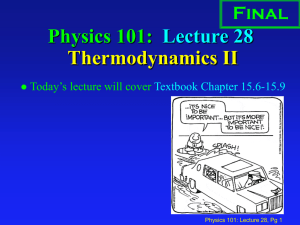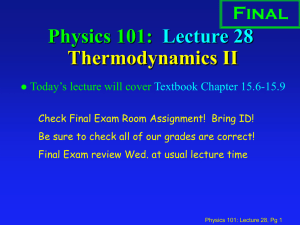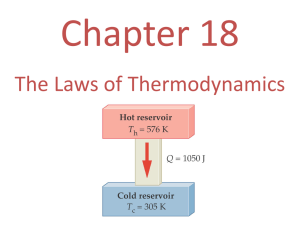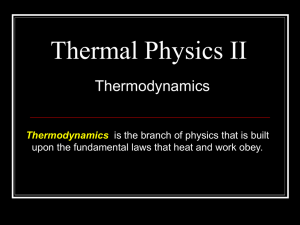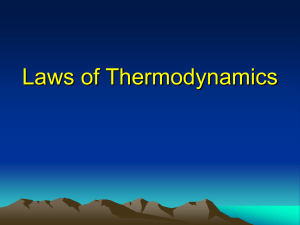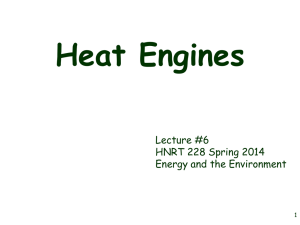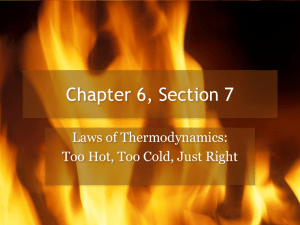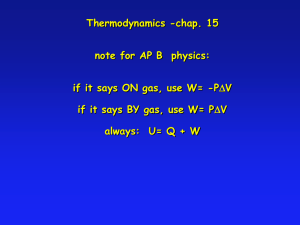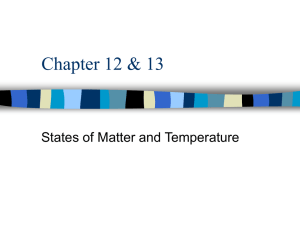First Law of Thermodynamics - Derry Area School District
advertisement
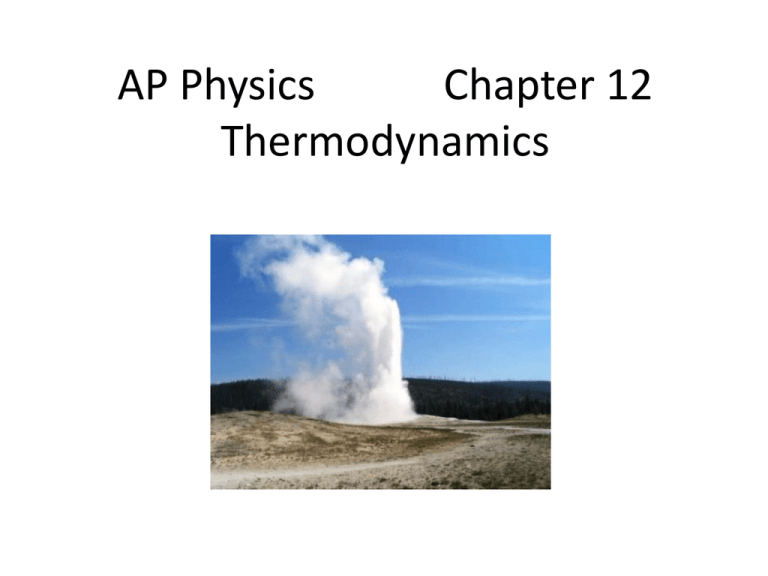
AP Physics Chapter 12 Thermodynamics Chapter 12: Thermodynamics 12.1 Thermodynamic Systems, States, and Processes 12.2 The First Law of Thermodynamics 12.3 The Second Law of Thermodynamics and Entropy 12.4 Heat Engines and Thermal Pumps 12.5 The Carnot Cycle and Ideal Heat Engines Learning Objectives A. Ideal Gases 1. Students will know how to apply the ideal gas law and thermodynamic principles, so they can: a. Relate the pressure and volume of a gas during isothermal expansion or compression. b. Relate the pressure and temperature of a gas during constantvolume heating or cooling, or the volume and temperature during constant-pressure heating or cooling. c. Calculate the work performed on or by a gas during an expansion or compression at constant pressure. d. Understand the process of adiabatic expansion or compression of a gas. e. Identify or sketch on a PV diagram the curves that represent each of the above processes. Learning Objectives B. Laws of Thermodynamics 1. Students will know how to apply the first law of thermodynamics, so they can: a. Relate heat absorbed by a gas, the work performed by the gas, and the internal energy change of the gas for any of the processes above. b. Relate work performed by a gas in a cyclic process to the area enclosed by a curve on a PV diagram. 2. Students will understand the second law of thermodynamics, the concept of entropy, and heat engines and the Carnot cycle, so they can: a. Determine when entropy will increase, decrease, or remain the same during a particular situation. b. Compute the maximum possible efficiency of a heat engine operating between two given temperatures. c. Compute the actual efficiency of a heat engine. d. Relate the heats exchanged at each thermal reservoir in a Carnot cycle to the temperatures of the reservoirs. Homework for Chapter 12 • Read Chapter 12 • HW 12.A: p. 412: 5, 6, 12-18, 22. • HW 12.B: p. 414-415: 29, 30, 47-49, 50-52, 54, 56, 57. • HW 12.C: Handout and p.416: 72-74; 76. 12.1: Thermodynamic Systems, States, and Processes Warmup: Are You a Conservationist? Physics Warmup #94 Conservation laws are the cornerstones of physics. When we say a quantity is conserved, we mean that the sum total of that quantity in a system never changes. Quantities that are known to be conserved include momentum, energy, angular momentum, and electric charge. Each has its own conservation law. ********************************************************************************************* Solve this anagram to identify one of the conservation laws in physics. an uncommon, softer motive Answer: conservation of momentum 12.1 Thermodynamic Systems, States, and Processes thermodynamics deals with the transfer or the actions (dynamics) of heat. - the study grew out of efforts to develop a engine that could convert heat to mechanical work (such as the steam engine.) system - a definate quantity of matter enclosed by boundaries or surfaces. ex: a real boundary, such a the gas contained in a pistoncylinder of an engine. ex: an imaginary boundary, such as a cubic meter of air in this room. thermally isolated system out of the system. - no heat transfer into or heat reservoir - a system with unlimited heat capacity so that the addition or removal of heat causes no change in its temperature. 12.1 Thermodynamic Systems, States, and Processes equations of state - describe the conditions of thermodynamic systems. - ex: ideal gas law: pV = NkBT is an equation of state. - state variables are p, V, T for a given mass process variables of a system. - a change in the state, or the thermodynamic reversible process - one with a known path through equilibrium states. - usually slow; path can be retraced. irreversible process - one for which the intermediate steps are nonequilibrium states. - usually fast - Irreversible does not mean that the system can’t be taken back to the initial state; it only means the process path can’t be retraced because of nonequilibrium conditions. Reversible vs. Irreversible Processes • If a process goes quickly from state 1 to state 2, the process is irreversible since we do not know the “path”. • However, if the gas is taken through many closely spaced states (as in going from state 3 to state 4), the process is reversible, at least in principle. • Reversible means “ exactly retraceable”. 12.2: The First Law of Thermodynamics Warmup: The Thrill of Conservation Physics Warmup #96 Roller Coasters are an excellent example of the conservation of energy. Work is done to raise the cars to the top of the first hill and then gravity transforms the energy back and forth between potential and kinetic for the rest of the ride. ********************************************************************************************* Cedar Point Amusement Park in Sandusky, OH is the self-proclaimed roller coaster capital of the world. One of its many coasters is the Magnum XL-200. It stands out above the horizon with a incredible drop of 59.3 meters on the first hill! Disregarding any loss of energy to friction, calculate the speed of the cars at the bottom of that first hill. Answer: 34.1 m/s 12.2 The First Law of Thermodynamics Disclaimer: The conventions we are using for WORK are NOT the same as our textbook uses. They are the conventions aligned with the AP exam. 12.2 The First Law of Thermodynamics The First Law of Thermodynamics is a statement of energy conservation for thermodynamic systems. ∆U = Q + W On Gold Sheet Q : heat ∆U : change in internal energy W: work Sign Convention (Very Important!) The system is the gas, fluid, etc. you are analyzing. +Q means heat added to the system -Q means heat removed from the system +W means work done on the system (compression) -W means work done by the system (expansion) 12.2 The First Law of Thermodynamics Example: A gas is kept in a cylinder that can be compressed by pushing down on a piston. You add 2500 J of heat to the system, and then you push the piston 1.0 m down with a constant force of 1800 N. What is the change in the gas’s internal energy? Solution: Q = + 2,500 J Work is done ON the gas to compress it, so W is positive. Since W = Force x distance = 1800 N x 1.0 m W = + 1800 J ∆U=Q+W = 2,500 J + 1800 J ∆ U = 4,300 J 12.2 The First Law of Thermodynamics Four Reversible Processes You Need to Know: 1) isobaric – constant pressure • At contant pressure, the work done by/on the gas is given by W = -pV = -p (V2 – V1) • • On Gold Sheet The work done is positive when V is negative, during compression. The work done is negative when V is positive, during expansion. In an isobaric process, the temperature of the gas increases as the volume increases, but the pressure doesn’t change. Since V/T is constant, as volume increases, so must temperature. Heat is added to the gas. The gas expands. Work is negative. W = - p∆V = - p (V2 – V1) 12.2 The First Law of Thermodynamics Four Reversible Processes You Need to Know: 2) isochoric – constant volume (aka isometric, isovolumetric) • V = 0, hence W = 0. • Hence Q = U (all the supplied heat goes into increasing the internal energy of the system.) In an isometric process, the volume remains constant. Since P/T must remain constant, as pressure increases, so must temperature. The change in volume is zero, so the work is zero. Q=∆U All the heat added to the gas goes towards increasing the internal energy of the gas. 12.2 The First Law of Thermodynamics Four Reversible Processes You Need to Know: 3) isothermal – constant temperature • U = 0, hence Q = -W. 4) adiabatic – thermally insulated; no heat is exchanged • Q = 0, hence U = W. In an isothermal process, the temperature stays constant, so ∆U = 0 and Q = -W Since PV is constant (Gas Laws), as one increases the other must decrease. Heat is added to the piston. The volume of the gas increase. Work was done by the gas, so Work is negative. In an adiabatic process, no heat is added or removed from the system. Q=0 and ∆U = W The change in internal energy of the gas is due to the work done on the gas. Here, work is done by the gas during expansion. Work is negative. Therefore, the internal energy and temperature decreases. W = - pV = - area Work done by a gas = area under the curve on a PV diagram. - + 12.2 The First Law of Thermodynamics Example 12.1: A system consists of 3.0 kg of water at 80°C. 25 J of work is done on the system by stirring with a paddle wheel, while 63 J of heat is removed. What is the change in internal energy of the system? 12.2 The First Law of Thermodynamics Example 12.2: During an adiabatic process, an ideal gas gained 5.0 J of internal energy. a) What is the heat involved in the process? b) What is the work done in the process? 12.2 The First Law of Thermodynamics Example 12.3: In an isometric process, the internal energy of a system decreases by 50 J. a) What is the work done? b) What is the heat exchange? 12.2 The First Law of Thermodynamics Example 12.3.1) 0.25 mole of gas is kept at 1150 K. The gas undergoes adiabatic expansion, reaching a final temperature of 400 K. How much work was done on or by the gas? P a 1150 K isotherm b 400 K isotherm V 12.2 The First Law of Thermodynamics: Check for Understanding 1. There may be an exchange of heat with the surroundings for a) a thermally isolated system b) a completely isolated system c) a heat reservoir d) none of these Answer: c 12.2 The First Law of Thermodynamics: Check for Understanding 2. On a PV diagram, a reversible process is one a) whose path is known b) whose path is unknown c) for which the intermediate steps are nonequilibrium states d) none of these Answer: a 12.2 The First Law of Thermodynamics: Check for Understanding 3. There is no exchange of heat in an a) isothermal process b) adiabatic process c) isobaric process d) isometric process Answer: b 12.2 The First Law of Thermodynamics: Check for Understanding 4. Positive work is work done a) on the system b) by the system c) for the system d) of the system Answer: a (compression) 12.2 The First Law of Thermodynamics: Check for Understanding 5. If heat is added to a system of ideal gas during an isothermal expansion process, a) work is done by the system b) the internal energy decreases c) the effect is the same as for an isometric process d) none of these Answer: a Homework for Chapter 12.1-2 • HW 12.A: p. 412: 5, 6, 12-18, 22. 12.3: The Second Law of Thermodynamics and Entropy Warmup: Perpetual Motion I Physics Warmup #98 Perpetual motion machines are machines that, once working, would keep on going by themselves. There are actually two types of these theoretical perpetual motion machines. A perpetual motion machine of the first kind is one in which the machine produces more energy than it uses while running. ********************************************************************************************* Use the laws of physics to explain why a perpetual motion machine of the first kind is theoretically impossible to build. Answer: The law of conservation of energy and the first law of thermodynamics do not allow for the creation of energy. 12.3 The Second Law of Thermodynamics and Entropy • The second law of thermodynamics specifies the direction in which a process can naturally or spontaneously take place. •This law can be stated in the following three different forms: 1. Clausius statement: (No perfect refrigerator) Heat, by itself, cannot flow from a body at lower temperature to a body at higher temperature. 2. Kelvin-Planck Statement: (No perfect heat engine) No heat engine working in a cyclic process will absorb heat from a single reservoir and convert it completely to work. 3. Entropy: In any thermodynamic process that proceeds from one equilibrium state to another, the entropy of a (system + environment) either remains unchanged or increases. 12.3 The Second Law of Thermodynamics and Entropy entropy - a measure of the disorder of a thermodynamic system and is related to heat and temperature. • Entropy is a thermodynamic quantity. It is a state variable i.e. its value depends on the state and not on the process by which the system is brought to that state. • Other state variables for a thermodynamic system include temperature, pressure, volume, and internal energy. The amount of heat Q and the work done are not state variables. Their values depend on the process connecting two states. • Entropy is related to randomness, chaos, or disorder of a thermodynamic system. An increase in the randomness, chaos, or disorder of a thermodynamic system implies an increase in the entropy of the system. • All isolated systems tend toward a state of greater disorder. Example: A glass falls off a shelf and breaks. To put that glass back together, and decrease the glass’s entropy, someone has to do the work. Understanding Entropy: Macrostates and Microstates • Take out 5 identical coins. There are 6 possible outcomes of heads and tails when the coins are thrown, as long as you don’t care which particular coin is a head or tail. These outcomes are called macrostates, and in this case they are 5H 4H1T 3H2T 2H3T 1H4T 5T • If you look at the 5H macrostate, you can see there’s only 1 way this macrostate can be achieved: All the coins must be heads. • If you look at the 4H1T macrostate, there are 5 ways to achieve it depending on which of the 5 coins is a head. You can say this macrostate has 5 microstates, and it has a higher entropy then the 5H macrostate. • The 3H2T and 2H3T macrostates each have 10 ways that they can be achieved; these macrostates each have 10 microstates, so they have a higher entropy than the 5H state or the 4H1T state. • When you throw the coins, each of the total of 32 = 25 microstates is equally likely, and the macrostate with the greatest number of microstates, the macrostate with the highest entropy, will be the most probable. Understanding Entropy: Macrostates and Microstates • The last sentence of the previous slide is really the essence of the second law. When you look at large systems like the ideal gas with 1023 particles, the most likely macrostate – described by p, V, and T and obeying the ideal gas law – has so many microstates associated with it that it’s the only one you have any chance of observing. • When you allow two systems at different temperatures to exchange energy with each other, the final macrostate of the system as a whole will be the one with the most number of microstates, maximizing entropy. • Now you can say why heat spontaneously flows from hot to cold: It’s overwhelmingly more likely than the alternative. In terms of entropy, the second law is: A closed system, or a system that won’t transfer energy to or from its surroundings, will always develop to maximize the entropy of the system. The entropy will never decrease. 12.3 The Second Law of Thermodynamics and Entropy • The entropy of an isolated system increases for every natural process. However, if a system is not isolated it may undergo a decrease in entropy. example for an isolated system: freezing ice. Water at room temperature will not spontaneously make ice. To freeze ice, we need to remove heat. This creates a decrease in entropy, or more order. example for a non-isolated system: Put an ice cube tray full of water in the freezer. The water will freeze as the ice cubes are made, and entropy is decreased. However, there will be a larger increase in entropy somewhere else in the environment (such as heat expelled by the refrigerator.) Question: As a computer performs its calculations, it is organizing information. Therefore, the computer’s entropy is decreasing. Is this a violation of the second law of thermodynamics? Answer: No. Order is increased by doing work on the closed system (the computer). In doing this, however, the computer releases heat, increasing the entropy of the rest of the world. 12.3 The Second Law of Thermodynamics and Entropy • For a system, the total change in entropy is the addition of the changes in entropy of the objects in the system. • For any thermodynamic process, entropy (system + environment) 0 • For irreversible processes, entropy (system + environment) > 0 • For reversible processes, entropy (system + environment) = 0 • For a reversible cycle, entropy (cycle) = 0 • For free expansion, entropy (system) > 0 • Adding heat (Q) to a system at a constant temperature increases its entropy. 12.3 Summary • Entropy is one of the arrows of time. The entropy of the universe is always increasing. This may lead to what is called the “heat death” of the universe. • Energy of the universe is constant; entropy is not! • Energy obeys the conservation law; entropy does not! First Law of Thermodynamics: YOU CAN’T WIN. - Energy is conserved. You can’t get energy out of nothing. Second Law of Thermodynamics: YOU CAN’T WIN; YOU CAN’T BREAK EVEN. - All the available energy cannot be converted into work. Third Law of Thermodynamics: - It is not possible to lower the temperature of any system to absolute zero. Doing so would violate the second law. 12.3 The Second Law of Thermodynamics and Entropy: Check for Understanding 1. The second law of thermodynamics a) describes the state of a system b) applies only when the first law is satisfied c) precludes perpetual motion machines d) does not apply to an isolated system. Answer: c 12.3 The Second Law of Thermodynamics and Entropy 2. In any natural process, the change in entropy of the universe is a) negative b) positive c) zero d) the same as the change in thermal energy Answer: b 12.3 The Second Law of Thermodynamics and Entropy 3. Do the entropies of the systems in the following processes increase or decrease? a) ice melts increases b) water vapor condenses decreases, since heat is removed c) water is heated on the stove increases, since heat is added d) food is cooled in a refrigerator decreases, since heat is removed 12.4: Heat Engines and Thermal Pumps Warmup: Perpetual Motion II Physics Warmup #99 Although the law of conservation of energy and the first law of thermodynamics do not allow for the possibility of a perpetual motion machine of the first kind, they do not forbid the possibility of a perpetual motion machine of the second kind. This machine would simply create an amount of energy equal to that required to run it, thus opening the possibility of its running itself forever, once started. ********************************************************************************************* Although the laws of physics referred to above do not prohibit such a machine, another law of physics does (the second law of thermodynamics). Use what you know about friction to explain why a perpetual motion machine of the second kind could not work. Answer: Friction between the parts would convert some of the energy to heat, which could not be totally retrieved. Perpetual motion machines don’t exist, but perpetual motion does. Example: planets orbit the sun. 12.4 Heat Engines and Thermal Pumps Review of the Second Law of Thermodynamics • Clausius Statement: Heat does not flow spontaneously from a colder body to a warmer body. This does not mean heat can not flow from a colder body to a warmer body, it just can not take place spontaneously. • Kevin-Planck Statement: In a thermal cycle, heat energy cannot be completely transformed to mechanical work. This does not mean energy is not conserved – it just means that 100% of heat energy cannot be converted to mechanical work in a cycle. • It is impossible to construct an operational perpetual motion machine. • The total entropy of the universe increases in every natural process. 12.4 Heat Engines and Thermal Pumps heat engine - any cyclic device that converts heat to work. It absorbs heat (Qhot or Qin) from a high temperature reservoir , does net work (Wnet), and exhausts heat (Qcold or Qout) to a low-temperature reservoir. Note the width of the arrow for Qin is equal to the combined widths of Qout and Wnet, reflecting the conservation of energy. 12.4 Heat Engines and Thermal Pumps This cyclic process consists of 2 isobars and 2 isomets. The net work output per cycle is the area of the rectangle formed by the process paths. For a general heat engine cycle, the net work per cycle is still represented by the area inside the cycle’s separate paths. After one cycle, every thermodynamic variable returns to its original value, including thermal energy U, so ∆U = 0. 12.4 Heat Engines and Thermal Pumps Example: The Otto Cycle (p. 404 in text) - the theoretical process cycle developed by Geman engineer Nickolas Otto (1832-1891). He used his design to build one of the first successful gasoline engines. 12.4 Heat Engines and Thermal Pumps thermal efficiency (εth) ratio of its work output and its heat input. εth = Wnet Qin Since Wnet engine is: = Qhot – Qcold, - of a heat engine is defined as the On Gold Sheet the thermal efficiency per cycle of a heat εth = Wnet = Qhot – Qcold = 1 - Qcold Qhot Qhot Qhot “Efficiency is what you get out for what you put in.” 12.4 Heat Engines and Thermal Pumps Example 12.6: A heat engine has an efficiency of 25% and extracts 120 J of heat from a hot reservoir per cycle. a) How much net work does it perform in each cycle? b) How much heat does it exhaust in each cycle? 12.4 Heat Engines and Thermal Pumps thermal pump - a device that transfers heat energy from a low temperature reservoir to a high temperature reservoir. To do this, work must be done, according to the second law of thermodynamics, since it will not happen on its own. Notice the width of the arrows, and how they represent the conservation of energy. 12.4 Heat Engines and Thermal Pumps An air conditioner is an example of a thermal pump. With work input, it transfers heat (Qcold) from a low–temperature reservoir (inside the house) to a hightemperature reservoir (outside). 12.4 Heat Engines and Thermal Pumps Another example of a thermal pump is a refrigerator. (p.406 in text( 12.4-5 Heat Engines and Thermal Pumps • In a refrigerator, heat (Qcold) is carried away from the interior by the refrigerant (used to be Freon, but now we use other substances). The refrigerant has a relatively low boiling point. The heat causes the refrigerant to boil and is carried away as latent heat of vaporization. • The vapor is drawn into the compressor. The compression increases the temperature of the gas, which is discharged from the compressor as superheated vapor. • This vapor condenses in the cooler condenser unit, where circulating air carries away the latent heat of fusion and the heat of compression and discharges it to the surroundings (Qhot). heat pump - a common commercial device used to cool homes in the summer and heat them in the winter. 12.4 Heat Engines and Thermal Pumps Example 12.7: A small container of gas undergoes a thermodynamic cycle. The gas begins at room temperature. First, the gas expands isobarically until its volume has doubled. Second, the gas expands adiabatically. Third, the gas is cooled isobarically; finally, the gas is compressed adiabatically until it returns to its original state. a) The initial state of the gas is indicated on the PV diagram below. Sketch this process on the graph. P initial state 1 2 4 3 V b) Is the temperature of the gas greater right before of right after the adiabatic expansion? Justify your answer. The temperature is greater right before the expansion. By definition, in an adiabatic process, no heat is added or removed. But because the gas expanded, work was done by the gas, meaning the W term in the first law of thermodynamics is negative. So, by U = Q + W, Q = 0 and W is negative; so U is negative as well. Internal energy is directly related to temperature. Therefore, because internal energy decreases, so does temperature. c) Is heat added to or removed from the gas in one cycle? In a full cycle, the gas begins and ends at the same state. So the total change in internal energy is zero. Now consider the total work done on or by the gas. When the gas expands in the first and second process, there’s more area under the graph than when the gas compresses in the second and third process. So, the gas does more work expanding than compressing; the net work is thus done by the gas, and is negative. To get no change in internal energy, the Q term in the first law of thermodynamics must be positive; heat must be added to the gas. d) Does this gas act as a refrigerator or a heat engine? This is a heat engine. Heat is added to the gas, and net work is done by the gas; that’s what a heat engine does. (In a refrigerator, net work is done on the gas, and heat is removed from the gas.) 12.4-5 Heat Engines and Thermal Pumps: Summary • For a cyclical process, at the end of one cycle the system is back to the same state and hence temperature. Therefore, for one cycle U = 0 and Q = -W • If W is negative and Q is positive, work is being done by the system and heat is added to the system. The cycle represents a heat engine (clockwise cycle). • If W is positive and Q is negative, work is being done on the system and heat is removed from the system. The cycle represents a heat pump/refrigerator (counterclockwise cycle). • A heat engine absorbs QH amount of heat form a hot reservoir at temperature TH, converts an amount W into work and rejects the rest QC to the cold reservoir at temperature TC. Hence, QH = W + QC (absolute values of quantities) • The efficiency (e) for a heat engine is given by e = W or QH e = QH – Q C QH or e = 1 - QC QH 12.4 Heat Engines and Thermal Pumps Check for Understanding 1. For a cyclic heat engine, a) εth > 1 b) Qhot = Wout c) ∆U = Wout d) Qhot > Qcold Answer: d 12.4 Heat Engines and Thermal Pumps Check for Understanding 2. A thermal pump a) is rated by thermal efficiency b) requires work input c) is not consistent with the 2nd law of thermodynamics d) violates the 1st law of thermodynamics Answer: b 12.4 Heat Engines and Thermal Pumps Check for Understanding 3. Is leaving a refrigerator door open a practical way to air condition a room? Explain. Answer: No. As a matter of fact, the room will be heated. The heat expelled to the room by the refrigerator is more than the heat removed by the refrigerator from the room. Homework for Chapter 12.3 & 12.4 • HW 12.B: p. 414-415: 29, 30, 47-49, 50-52, 54, 56, 57. 12.5: The Carnot Cycle and Ideal Heat Engines Warmup: A Clean Start Physics Warmup #179 In 2003, a company in Germany created an interactive washing machine. It understands spoken-word commands, such as, “Prewash, then hot wash at 95 degrees, then spin at 1,400 revolutions.” It can also give verbal instructions on how to use the machine! Of course, this all comes with a price. ********************************************************************************************* The inventors of the interactive washing machine have been quoted as saying that it is needed because electronic appliances have become too complicated for consumers to use. However, some critics have suggested that this may be a misplaced attempt to aid the technology challenged consumer. Choose a different appliance in which a similar voice-recognition system would provide a greater benefit to its user and explain how it would help. 12.5 The Carnot Cycle and Ideal Heat Engines Fact: Due to the second law of thermodynamics, any cyclic heat engine must exhaust some heat energy. Therefore, no real engine can be 100% efficient. Question: What is the maximum possible efficiency of a heat engine? Sadi Carnot (1796-1832), a French engineer, studied this very question. Carnot cycle the ideal for a heat engine, consists of two isothermal and two adiabatic processes. Heat is absorbed during the isothermal expansion and exhausted during the isothermal compression. 12.5 The Carnot Cycle and Ideal Heat Engines Carnot efficiency (εc) - gives the upper limit of efficiency (unattainable in the real world). εc = 1 – Tcold = Thot Thot – Tcold Thot On Gold Sheet where Thot and Tcold are the Kelvin temperatures of the low-temperature and high-temperature reservoirs, respectively. •The greater the difference in temperatures of the heat reservoirs, the greater the Carnot efficiency. example: If Thot is twice Tcold, then the Carnot efficiency will be: εc = 1 – Tcold = 1 – 0.50 = 0.50 = 50% Thot however, if Thot is four times Tcold, then the Carnot efficiency will be: εc = 1 – Tcold = Thot 1 – 0.25 = 0.75 = 75% 12.5 The Carnot Cycle and Ideal Heat Engines relative efficiency - the ratio of the thermal efficiency to the Carnot efficiency. εrel = εth εC example: A gasoline engine has a thermal efficiency of 20% and a Carnot efficiency of 30%. What is its relative efficiency? εrel = εth = 0.20 = 67% εC 0.30 12.5 The Carnot Cycle and Ideal Heat Engines Example 12.8: What is the Carnot efficiency of a gasoline engine which operates between 450 K and room temperature, 300K? 12.5 The Carnot Cycle and Ideal Heat Engines the third law of thermodynamics never been observed experimentally. - absolute zero has • If it were, this would in effect violate the second law. Reducing the entropy of a system requires increasing the entropy of its surroundings. • In cryogenic experiments, scientist have come close to absolute zero – to about 2.0 x 10-8 K) – but have never reached it. 12.5 The Carnot Cycle and Ideal Heat Engines: Summary • A Carnot engine is an ideal engine which has maximum possible efficiency for given temperature of the cold and hot reservoirs. For the Carnot engine QC = TC QH TH where the temperatures are measured in kelvin. • The efficiency of the Carnot engine can be written as e = 1 – TC TH 12.5 The Carnot Cycle and Ideal Heat Engines: Check for Understanding 1. The Carnot cycle consists of a) two isobaric and two isothermal processes b) two isometric and two adiabatic processes c) two adiabatic and two isothermal processes d) four arbitrary processes that return the system to its initial state. Answer: c 12.5 The Carnot Cycle and Ideal Heat Engines: Check for Understanding 2. Which of the following temperature reservoir relationships would have the highest efficiency for a Carnot engine? a) Tcold = 0.15 Thot b) Tcold = 0.25 Thot c) Tcold = 0.50 Thot d) Tcold = 0.90 Thot Answer: a 12.5 The Carnot Cycle and Ideal Heat Engines: Check for Understanding 3. Diesel engines are more efficient than gasoline engines. Which type of engine runs hotter? Why? Answer: Diesel engines run hotter as diesel fuel burns at a higher temperature. According to Carnot efficiency, the higher the hot reservoir temperature, the higher the efficiency. Homework for Chapter 12.5 • HW 12.C: Handout and p.416: 72-74; 76. Formulas for Chapter 12 U = Q + W First Law of Thermodynamics + Q is heat added to the system -Q is heat removed from the system + W is work done on the system - W is work done by the system W = - p V Calculates the work done by an expanding gas at constant pressure. It is negative. =W c QH Defines and computes the thermal efficiency of a heat engine. = TH – TC TH Defines and calculates the Carnot efficiency of an ideal heat engine.
